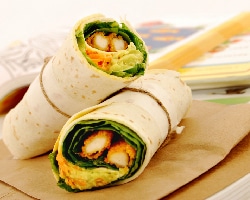
As you cruise down the supermarket aisles with kids asking for all sorts of junk for their school lunches, it can be difficult to resist the urge to grab those pre-packaged, all-in-one lunch meals. But healthy, homemade lunches that your kids will want to eat are actually easier than you might think.
Most processed foods are full of sugars, sodium, nitrates and other chemical preservatives, and artificial ingredients, none of which, studies have shown, will give your child the nutrients and energy needed for a day full of learning.
When it comes to lunches your kids will want to eat, start by thinking variety and simplicity. Many kids get bored with eating the same thing every day, and kids who get bored get trading-which means they could end up eating junk regardless of your efforts.
Simplicity enters the equation in two ways: simple preparation, and simple all-natural ingredients. Just as you would avoid processed foods, choose organic fruits and vegetables and other natural foods to prevent your child from ingesting pesticide residue.
There are plenty of healthy snacks that are easy to prepare either ahead of time or in a rush. Cookies are a big hit, and they can be healthy if you make your own, so set aside an hour or two on the weekend for baking with the kids.
When you're making dinner, cut up extra vegetables for the next day's lunches. If you've forgotten, just wash up some cherry tomatoes and berries in the morning, or throw some organic corn kernels in the air popper for fresh, chemical-free popcorn while you're making your morning coffee.
Homemade trail mix is also easy and kid-friendly. Let each child make a personalized blend of nuts, dried fruits, and a small amount of all-natural or organic chocolate as a bonus treat. Just be sure to check with the school and teacher about policies regarding nuts since many kids have severe nut allergies.
For lunches, keep the kids guessing by alternating wraps, pitas, veggies and hummus, sandwiches, salads and anything else you can think of. Avoid processed foods such as sandwich meats, which are usually high in sodium and nitrates. If your child has an obsession with sandwich meats, look for low-fat, nitrate-free options.
Make the most of the previous night's leftovers. Use strips of steak, lean ground beef, or beans to fill a whole grain wrap or pita, topping things off with fresh, organic vegetables and a sprinkling of cheese. If everyone was hungry the night before, pop open a can of wild (not farmed) flaked tuna or salmon for a nutrient-rich protein. Making homemade pizza for dinner? Make extra personal pizzas for the kids' lunches.
As you start to think about healthy meals, take a moment to consider what you're packaging your kids' meals in. Many parents still use disposable bags and plastic wraps, but it's a total waste of money and it produces unnecessary waste. A reusable container is the way to go, but not all containers are created equally.
Studies have shown plastics can leech chemicals such as bisphenol A (BPA) and antimony, but if you're set on using plastic containers, look for polypropylene, designated by the number 5, as it is one of the most stable options. If possible health concerns have you worried about using any plastic, there are more stainless steel lunch containers on the market every year, so they shouldn't be hard to find.
When it comes to drink containers, it's important to remember that what you put in the container can have an effect on the quantity of chemicals that leech into the drink. Studies have shown that heat and acidic drinks such as juices can increase the rate at which chemicals leech into the beverage.
Stainless steel bottles can be safer, but only if you choose the right one. Many stainless steel drinking containers are treated with a coating on the inside, and some of these coatings also contain BPA. Also keep in mind that many come with a plastic cap or spout, which could come in contact with the drink. If your search has been fruitless, Kleen Kanteen's bottles are BPA-free, and they make a bottle with a stainless steel screw cap.
Making school lunches can be frustrating at times, but your child's health is worth a little aggravation. The savings on food costs is just a bonus.




